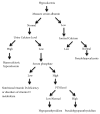Clinical Approach to Hypocalcemia in Newborn Period and Infancy: Who Should Be Treated?
- PMID: 31320908
- PMCID: PMC6607701
- DOI: 10.1155/2019/4318075
Clinical Approach to Hypocalcemia in Newborn Period and Infancy: Who Should Be Treated?
Abstract
Introduction: Hypocalcemia is a common metabolic problem in newborn period and infancy. There is consensus on the treatment of the symptomatic cases while the calcium level at which the treatment will be initiated and the treatment options are still controversial in asymptomatic hypocalcemia.
Methods: This review article will cover hypocalcemia with specific reference to calcium homeostasis and definition, etiology, diagnosis, and treatment of hypocalcemia in newborn and infancy period.
Results: Hypocalcemia is defined as total serum calcium <8 mg/dL (2 mmol/L) or ionized calcium <4.4 mg/dL (1.1 mmol/L) for term infants or preterm infants weighing >1500 g at birth and total serum calcium <7 mg/dL (1.75 mmol/L) or ionized calcium <4 mg/dL (1 mmol/L) for very low birth weight infants weighing <1500 g. Early-onset hypocalcemia is generally asymptomatic; therefore, screening for hypocalcemia at the 24th and 48th hour after birth is warranted for infants with high risk of developing hypocalcemia. Late-onset hypocalcemia, which is generally symptomatic, develops after the first 72 h and toward the end of the first week of life. Excessive phosphate intake, hypomagnesemia, hypoparathyroidism, and vitamin D deficiency are commonest causes of late-onset hypocalcemia. Hypocalcemia should be treated according to etiology. Calcium replacement is the cornerstone of the treatment. Elementary calcium replacement of 40 to 80 mg/kg/d is recommended for asymptomatic newborns. Elementary calcium of 10 to 20 mg/kg (1-2 mL/kg/dose 10% calcium gluconate) is given as a slow intravenous infusion in the acute treatment of hypocalcemia in patients with symptoms of tetany or hypocalcemic convulsion.
Conclusion: Since most infants with hypocalcemia are usually asymptomatic, serum total or ionized calcium levels must be monitored in preterm infants with a gestational age <32 weeks, small for gestational age infants, infants of diabetic mothers, and infants with severe prenatal asphyxia with a 1 min Apgar score of <4. The treatment of hypocalcemia should be initiated immediately in infants with reduced calcium levels while investigating the etiology.
Figures

Similar articles
-
Vitamin D levels in newborns and association with neonatal hypocalcemia.J Matern Fetal Neonatal Med. 2018 Jul;31(14):1889-1893. doi: 10.1080/14767058.2017.1331430. Epub 2017 Jun 14. J Matern Fetal Neonatal Med. 2018. PMID: 28610460
-
Postnatal changes in calcium-regulating hormones in very-low-birth-weight infants. Effect of early neonatal hypocalcemia and intravenous calcium infusion on serum parathyroid hormone and calcitonin homeostasis.Am J Dis Child. 1985 Sep;139(9):913-6. doi: 10.1001/archpedi.1985.02140110067031. Am J Dis Child. 1985. PMID: 4036926
-
Effect of hypocalcemia on cardiac function in very-low-birth-weight preterm neonates: studies of blood ionized calcium, echocardiography, and cardiac effect of intravenous calcium therapy.Pediatrics. 1985 Oct;76(4):543-50. Pediatrics. 1985. PMID: 4047796
-
Hypocalcemia in the newborn.Indian J Pediatr. 2001 Oct;68(10):973-5. doi: 10.1007/BF02722599. Indian J Pediatr. 2001. PMID: 11758136 Review.
-
Hypoparathyroidism.Best Pract Res Clin Endocrinol Metab. 2012 Aug;26(4):517-22. doi: 10.1016/j.beem.2012.01.004. Epub 2012 May 31. Best Pract Res Clin Endocrinol Metab. 2012. PMID: 22863393 Review.
Cited by
-
Hypocalcemia as a Cause of Complex Febrile Seizures in a Toddler.Case Rep Pediatr. 2021 Jul 13;2021:1798741. doi: 10.1155/2021/1798741. eCollection 2021. Case Rep Pediatr. 2021. PMID: 34336337 Free PMC article.
-
Effect of Light-Emitting Diode Phototherapy on Serum Calcium Levels in Neonates With Jaundice.Cureus. 2022 Apr 7;14(4):e23938. doi: 10.7759/cureus.23938. eCollection 2022 Apr. Cureus. 2022. PMID: 35547456 Free PMC article.
-
Interrelationship between Vitamin D and Calcium in Obesity and Its Comorbid Conditions.Nutrients. 2022 Aug 3;14(15):3187. doi: 10.3390/nu14153187. Nutrients. 2022. PMID: 35956362 Free PMC article. Review.
-
A Case of Severe Neonatal Hypocalcemia Treated With Continuous Enteral Calcium.AACE Clin Case Rep. 2023 Apr 13;9(3):85-88. doi: 10.1016/j.aace.2023.04.003. eCollection 2023 May-Jun. AACE Clin Case Rep. 2023. PMID: 37251976 Free PMC article.
-
Autosomal Dominant Hypocalcemia Type 1 and Neonatal Focal Seizures.Children (Basel). 2023 Jun 3;10(6):1011. doi: 10.3390/children10061011. Children (Basel). 2023. PMID: 37371242 Free PMC article.
References
Publication types
LinkOut - more resources
Full Text Sources

